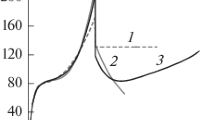To evaluate the character of the changes in the thermodynamic properties of mixed uranium–plutonium oxide fuel having high reactivity and toxicity, measurements have been performed on uranium–cerium oxides with analogous properties. The electromotive force of a solid-electrolyte galvanic cell and solid-phase coulonometric titration were used to establish the regularities of the variation of the oxygen potential versus the oxygen/metal ratio for the oxide U0.718Ce0.282O2–x . A thermodynamic model of uranium dioxide with elements dissolved in the matrix was developed; the model makes it possible to determine the oxygen potential in a wide interval of temperatures and non-stoichiometry.
Similar content being viewed by others
References
R. Kandan, R. Babu, and K. Nagarajan, “Calorimetric measurements on uranium–plutonium mixed oxides,” J. Nucl. Mater., 324, 215–219 (2004).
M. Kato, T. Tamura, and K. Konashi, “Oxygen potentials of plutonium and uranium mixed oxide,” ibid., 344, 235–239 (2005).
P. Rao, S. Anthonysamy, and M. Krishnaiah, “Oxygen potential and thermal conductivity of (U,Pu) mixed oxides,” ibid., 348, 329–334 (2006).
Y.-M. Lee, S.-H. Kim, and D.-J. Kim, “The role of oxygen potential in the sintering of UO2 – 5 wt% CeO2 powder mixed with M3O8 (M = U + Ce),” ibid., 344, 254–258 (2005).
A. Jain, K. Ananthasivan, and S. Anthonysamy, “Synthesis and sintering of (U0.72Ce0.28)O2 solid solution,” ibid., 345, 245–253 (2005).
D. Norris and P. Kay, “Oxygen potential and lattice parameter measurements in (U, Ce)O2–x ,” ibid., 116, No. 2/3, 184–194 (1983).
N. A. Ivanova,Yu. G. Godin, and V. G. Baranov, “Effect of the non-stoichiometry on the thermodynamic properties of uranium dioxide with additions of aluminum, silicon, and niobium oxides,” Neorgan. Materialy, 39, No. 7, 837–842 (2003).
N. A. Ivanova and V. G. Baranov, “Oxygen potential of uranium–cerium oxide,” Perspekt. Materialy, No. 4, 40–44 (2008).
S. A. Balankin and V. S. Sokolov, Thermodynamic Stability of High-Temperature Compounds of Uranium, MIFI, Moscow (1987).
P. V. Kovtunenko, Physical Chemistry of Solids: Crystals with Defects, Vysshaya Shkola, Moscow (1993).
P. Kofstadt, Non-Stoichiometry, Diffusion, and Electrical Conductivity in Binary Metal Oxides, Wiley New York (1972) [Russian translation, Mir (1975)].
Author information
Authors and Affiliations
Additional information
Translated from Atomnaya Énergiya,Vol. 106, No. 4, pp. 195–198, April, 2009.
Rights and permissions
About this article
Cite this article
Baranov, V.G., Ivanova, N.A. Model for calculating the thermodynamic characteristics of alloyed uranium dioxide. At Energy 106, 247–250 (2009). https://doi.org/10.1007/s10512-009-9159-5
Received:
Published:
Issue Date:
DOI: https://doi.org/10.1007/s10512-009-9159-5



